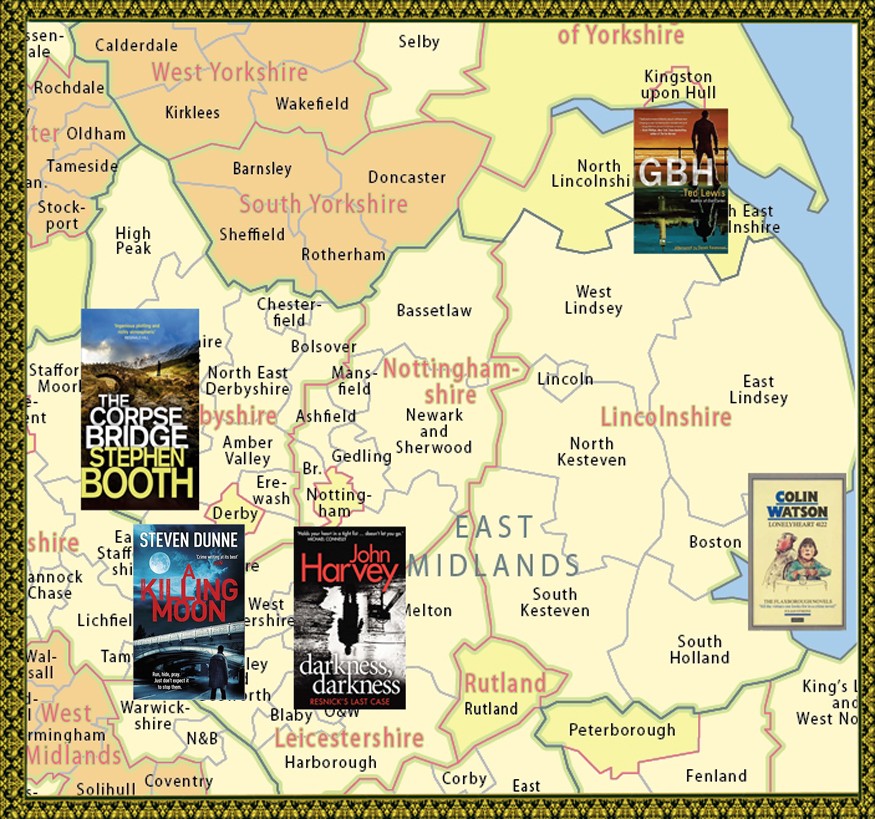
Our gazetteer of British crime is back and in this instalment we’re off to an area of England that gave birth to the great literary talent DH Lawrence and was also home to that publishing industry institution the Ladybird books. Yes, it’s the East Midlands and as we’ll discover there’s more to it than Walkers crisps, pork pies and paint factories.
In case you’ve missed our previous gazetteer entries, we’ve been to Northern Ireland, West Midlands, North East, South West, East Anglia and Scotland. If you come back soon, we’ll be off somewhere else, but let’s turn our eye to the centre of England.
Part 7: The East Midlands
Sometimes called The Shires, we aren’t talking about a Tolkien spin-off but the counties of Derbyshire, Leicestershire, Lincolnshire and Nottinghamshire. Only Lincolnshire has a coastline, and Leicestershire is usually known for its fox-hunting traditions, trademark pork pies and delicious cheese. However, we have four authors – two living and two dead – who have in their own ways made an indelible mark on British crime fiction.
Although John Harvey has written excellent stand-alone novels, it is for the lugubrious and jazz-loving Charlie Resnick series that he is best known. Memorably brought to life on the small screen by Tom Wilkinson, Resnick polices his home city of Nottingham with a fatalistic view of life. The first novel in the series, Lonely Hearts was published in 1989 and was named by The Times as one of the 100 greatest crime novels of the 20th century. What appears to be the final novel in the set was published in 2014. Darkness, Darkness is set against the bitterness which is the lasting legacy of the 1984 Miners’ Strike and is a wonderful read whether you care for politics or not.
Stephen Booth uses Derbyshire’s Peak District – just at the northern edge of he East Midlands – as the stomping ground for his police detectives Ben Cooper and Diane Fry. Booth himself was born in the Northwest, in Burnley to be precise, but hit the ground running in 2000 with Black Dog, first in the series. He has since written 13 more books in Cooper and Fry novels, and you can follow the links to read our reviews of Already Dead and The Corpse Bridge. Booth uses the High Peak as a third main character in his novels, and as you read you will need to be warmly wrapped up and prepared for all kinds of weather.
Colin Watson brought us Flaxborough. Not a real place in one sense, but very much an accurate portrait of market towns in south Lincolnshire. Sleaford, perhaps? Boston? Boston is a port town, much diminished from its glory days, but still looking eastward to the North Sea, as is Flaxborough. A large part of Watson’s professional life was spent as a newspaper reporter in and around Boston. His Flaxborough novels feature Inspector Purbright, a mild-mannered individual whose placid exterior masks a keen intelligence and a very keen nose for mischief. Watson’s wonderful use of language, and his subtlety, have rightly earned him a place at the top table of British crime fiction. Click the link to read our feature on The Flaxborough Chronicles.
“Ted Lewis? Surely he’s a proper Geordie? That’s where Michael Caine went in Get Carter, up to Newcastle?” Well, while it’s true that the classic film was set in Newcastle, Lewis aficionados will know that the book on which it was based – Jack’s Return Home – was set in and around the former steel making town of Scunthorpe, in North Lincolnshire. Lewis was born in Manchester, but his family moved to Barton-on-Humber, and it was there that Lewis died in 1982, in his mother’s house, a great writer but a hopeless alcoholic. Much of his final novel, GBH, is set in the Lincolnshire seaside town of Mablethorpe. Lewis describes it very much as an out-of-season wasteland, full of seedy bars and tatty talent shows. It was a place he would have been familiar with as a child, and you can read our appreciation of Ted Lewis and his writing by clicking this link.
Finally, there’s Steven Dunne, whose Damen Brook novels are set in the redbrick city of Derby. “Derby is perfect,” Dunne told us in an interview. “It has the wildness of the Peaks to the north and the city is compact enough to have a small-town neighbourly feel and is well integrated racially. Its population is straight talking and hard working – in short, Derby is a very pleasant place to live and work. Even better, there are no other thriller writers describing serial killers stalking its streets – yet – so I have the place to myself.” He’s also produced a very fine police procedural series there, the most recent of which is A Killing Moon, and nary a bunnyman in sight…
And for a true East Midlands crime story, try Code of a Killer on DVD, which tells the story of the first use of DNA in a murder prosecution. It’s set in the Leicestershire village of Narnborough, as well as at the University of Leicester, where Dr Alex Jefferies developed the first genetic fingerprinting techniques.